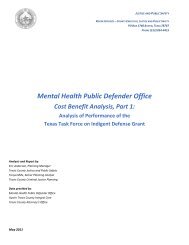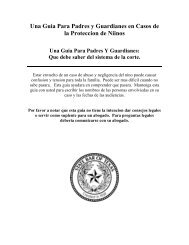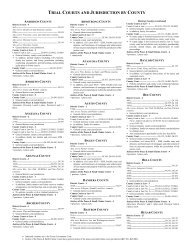1 Texas Judicial Council Juvenile Justice Committee - Texas Courts ...
1 Texas Judicial Council Juvenile Justice Committee - Texas Courts ...
1 Texas Judicial Council Juvenile Justice Committee - Texas Courts ...
You also want an ePaper? Increase the reach of your titles
YUMPU automatically turns print PDFs into web optimized ePapers that Google loves.
<strong>Texas</strong> <strong>Judicial</strong> <strong>Council</strong><br />
<strong>Juvenile</strong> <strong>Justice</strong> <strong>Committee</strong><br />
Subcommittee on Legislation<br />
August 31, 2012<br />
In recent years, the adjudication of children for fine-only misdemeanors has piqued the attention of<br />
critics and, in turn, the media. Laws passed more recently suggest the <strong>Texas</strong> Legislature and Governor<br />
Perry realize that the criminalization of misbehavior by children should be subject to restraints and that<br />
the unbridled outsourcing of school discipline from the school house to the court house is bad public<br />
policy. Yet, at the same time, efforts to decriminalize truancy in 2011 and substantially curtail<br />
ticketing at schools in 2009 and 2011 failed to gain traction at the Capitol. While critics assert that<br />
such cases should be returned to the civil juvenile justice system, neither juvenile courts nor juvenile<br />
probation services are prepared to shoulder the caseload of conduct indicating a need for supervision<br />
(CINS) petitions which have been shifted to municipal and justice courts in the form of Class C<br />
misdemeanors.<br />
From the government’s perspective, municipal and justice courts provide a rapid, cost-effective means<br />
of adjudicating cases. When it comes to the ability to manage extremely large caseloads, such courts<br />
have no equal in the <strong>Texas</strong> judicial system. These attributes alone, however, hardly make these courts<br />
ideal venues for cases involving children. With this said, numerous legislative changes in the last<br />
decade have made municipal and justice courts better venues for cases involving children (e.g.,<br />
mandatory IDEA training for municipal judges and justices of the peace, the advent of juvenile case<br />
manager programs). There is scant evidence that the Legislature is ready, willing, or even<br />
contemplating an overhaul of which courts should have jurisdiction of children who violate the law but<br />
are not necessarily engaging in delinquent conduct. Proposals that are viewed as “soft on crime” or<br />
that are perceived as making public schools “safe harbors” for criminality are unlikely to be passed<br />
into law. Accordingly, the greatest likelihood for effecting meaningful change lies in implementing<br />
common sense solutions that substantially curtail the “classroom-to-courtroom pipeline” and ensure<br />
equitable treatment for children who are adjudicated in municipal and justice courts.<br />
<strong>Texas</strong> <strong>Judicial</strong> <strong>Council</strong> <strong>Juvenile</strong> <strong>Justice</strong> <strong>Committee</strong> Charge:<br />
With the preceding in mind, Chief <strong>Justice</strong> Wallace B. Jefferson formed a <strong>Juvenile</strong> <strong>Justice</strong> <strong>Committee</strong><br />
of the <strong>Texas</strong> <strong>Judicial</strong> <strong>Council</strong> to:<br />
“Assess the impact of school discipline and school-based policing on referrals to the municipal,<br />
justice, and juvenile courts and identify judicial policies or initiatives that: work to reduce<br />
referrals without having a negative impact on school safety; limit recidivism; and preserve<br />
judicial resources for students who are in need of this type of intervention.”<br />
1
<strong>Juvenile</strong> <strong>Justice</strong> Legislative Subcommittee Recommendations:<br />
The <strong>Juvenile</strong> <strong>Justice</strong> <strong>Committee</strong> met on February 2, 2012 and March 29, 2012 to discuss potential<br />
recommendations to address the committee’s charge. Based upon those meetings, the Legislative<br />
Subcommittee recommends the following:<br />
1. The Legislature should expressly authorize local governments to implement “deferred<br />
prosecution” measures in Class C misdemeanors to decrease the number of local filings from<br />
schools. (See, I. DIVERSIONS, Page 2)<br />
2. The Legislature should amend applicable criminal laws to ensure that local courts are the last<br />
and not the first step in school discipline (i.e., Amend Section 8.07 of the Penal Code to create<br />
a rebuttable presumption that a child younger than age 15 is presumed to not have criminal<br />
intent to commit a Class C Misdemeanors - with exception for traffic offenses). This could be<br />
limited to Chapter 37, Education Code offenses but would make more sense to apply to all<br />
children. (See, II. CAPACITY, Page 11)<br />
3. The Legislature should amend offenses relating to Disruption of Class, Disruption of<br />
Transportation, and Disorderly Conduct so that age (not grade level) is a prima facie element of<br />
the offense. (See, II. CAPACITY, Page 11)<br />
4. The Legislature should amend existing criminal law and procedures to increase parity between<br />
“criminal juvenile justice in local trial courts” and “civil juvenile justice in juvenile court and<br />
juvenile probation.” (See, III. PARITY, Page 16)<br />
The Data Collection and Best Practices Subcommittee recommendations are found on another report.<br />
I. DIVERSIONS<br />
Recommendation: The Legislature should expressly authorize local governments to implement<br />
“deferred prosecution” measures in Class C misdemeanors to decrease the number of local filings<br />
from schools.<br />
Suggested Statutory Changes:<br />
CODE OF CRIMINAL PROCEDURE<br />
TITLE 1. CODE OF CRIMINAL PROCEDURE<br />
CHAPTER 45. JUSTICE AND MUNICIPAL COURTS<br />
Art. 45.056. JUVENILE CASE MANAGERS.<br />
(a) On approval of the commissioners court, city council, school district board of trustees,<br />
juvenile board, or other appropriate authority, a county court, justice court, municipal court, school<br />
district, juvenile probation department, or other appropriate governmental entity may:<br />
(1) employ a case manager to provide services in cases involving juvenile offenders<br />
who are before a court consistent with the court's statutory powers or referred to a court by a school<br />
administrator or designee for misconduct that would otherwise be within the court's statutory powers<br />
prior to a case being filed; or<br />
(2) agree in accordance with Chapter 791, Government Code, to jointly employ a case<br />
manager.<br />
2
(b) A local entity may apply or more than one local entity may jointly apply to the criminal<br />
justice division of the governor's office for reimbursement of all or part of the costs of employing one<br />
or more juvenile case managers from funds appropriated to the governor's office or otherwise available<br />
for that purpose. To be eligible for reimbursement, the entity applying must present to the governor's<br />
office a comprehensive plan to reduce juvenile crimes in the entity's jurisdiction that addresses the role<br />
of the case manager in that effort.<br />
(c) A county or justice court on approval of the commissioners court or a municipality or<br />
municipal court on approval of the city council may employ one or more juvenile case managers to<br />
assist the court in administering the court's juvenile docket, and in supervising its court orders in<br />
juvenile cases, and to provide prevention services to juveniles considered at-risk and intervention<br />
services to juveniles engaged in misconduct prior to cases being filed.<br />
Commentary: One of the ways that the juvenile courts differ from criminal courts is that informal<br />
diversion is preferred to formal adjudication. One of the reasons that the number of CINS petitions<br />
adjudicated in juvenile courts has declined to fewer than 1,000 per year is that Title 3, Chapter 52 of<br />
the Family Code contains ways to dispose of such cases without referral to juvenile court. Comparable<br />
provisions governing Class C misdemeanors do not exist.<br />
Conceptualized and advocated by University of <strong>Texas</strong> Professor Robert O. Dawson until his death in<br />
2005, juvenile case manager programs are still a relatively new and emerging addition to the municipal<br />
and justice court. In places like the City of Houston, where juvenile case managers have become<br />
integral to informal “deferred prosecution” measures of Class C misdemeanors, case filings have<br />
decreased and prosecutorial and judicial resources have been conserved. Efforts to decrease the<br />
number of cases adjudicated by municipal and justice courts through diversion efforts at the local<br />
government level should be encouraged. Accordingly, Article 45.056 of the Code of Criminal<br />
Procedure should be revised to allow juvenile case managers to be involved in diversion measures<br />
without the entry of any formal court order and to expressly allow juvenile case managers to provide<br />
prevention services to juveniles considered at-risk and intervention services to juveniles engaged in<br />
misconduct prior to cases being filed.<br />
EDUCATION CODE<br />
TITLE 2. PUBLIC EDUCATION<br />
SUBTITLE E. STUDENTS AND PARENTS<br />
CHAPTER 25. ADMISSION, TRANSFER, AND ATTENDANCE<br />
Sec. 25.0915. TRUANCY PREVENTION MEASURES; REFERRAL AND FILING<br />
REQUIREMENT.<br />
(a) A school district shall adopt truancy prevention measures designed to:<br />
(1) address student conduct related to truancy in the school setting;<br />
(2) minimize the need for referrals to juvenile court for conduct described by Section<br />
51.03(b)(2), Family Code; and<br />
(3) minimize the filing of complaints in county, justice, and municipal courts alleging<br />
a violation of Section 25.094.<br />
3
(b) Each referral to juvenile court for conduct described by Section 51.03(b)(2), Family Code,<br />
or complaint filed in county, justice, or municipal court alleging a violation by a student of Section<br />
25.094 must:<br />
(1) be accompanied by a statement from the student's school certifying that:<br />
(A) the school applied the truancy prevention measures adopted under<br />
Subsection (a) to the student; and<br />
(B) the truancy prevention measures failed to meaningfully address the<br />
student's school attendance; and<br />
(2) specify whether the student is eligible for or receives special education services<br />
under Subchapter A, Chapter 29.<br />
(c) A court shall dismiss a complaint or referral made by a school district under this section<br />
that is not made in compliance with this section.<br />
Commentary: In 2011, Section 25.0915 of the Education Code was added to ensure that schools first<br />
attempt truancy prevention measures to address non-attendance of before referring a child to juvenile<br />
court or pursuing criminal charges against the child in county, justice, or municipal court. Anecdotal<br />
evidence from some courts suggests that such measures help reduce the number of school attendance<br />
cases being filed and conserve limited local judicial resources. This amendment clarifies legislative<br />
intent from 2011. Specifically, if a complaint or referral is not made in compliance with Section<br />
25.0915, a court shall dismiss the allegation. This is identical to the legal requirement governing what<br />
is to occur when a school does not timely file a school attendance complaint (Sec. 25.0951(d),<br />
Education Code). Because most children accused of not attending school do not have the assistance of<br />
counsel, such provisions are necessary to ensure the execution of the Legislature’s intent.<br />
EDUCATION CODE<br />
TITLE 2. PUBLIC EDUCATION<br />
SUBTITLE G. SAFE SCHOOLS<br />
CHAPTER 37. DISCIPLINE; LAW AND ORDER<br />
SUBCHAPTER C. LAW AND ORDER<br />
Sec. 37.081. SCHOOL DISTRICT PEACE OFFICERS AND SECURITY PERSONNEL.<br />
(a) The board of trustees of any school district may employ security personnel and may commission<br />
peace officers to carry out this subchapter. If a board of trustees authorizes a person employed as<br />
security personnel to carry a weapon, the person must be a commissioned peace officer. The<br />
jurisdiction of a peace officer or security personnel under this section shall be determined by the board<br />
of trustees and may include all territory in the boundaries of the school district and all property outside<br />
the boundaries of the district that is owned, leased, or rented by or otherwise under the control of the<br />
school district and the board of trustees that employ the peace officer or security personnel.<br />
(b) In a peace officer's jurisdiction, a peace officer commissioned under this section:<br />
(1) has the powers, privileges, and immunities of peace officers;<br />
(2) may enforce all laws, including municipal ordinances, county ordinances, and<br />
state laws; and<br />
(3) may, in accordance with Chapter 52, Family Code, take a juvenile into custody.;<br />
and<br />
(4) may dispose of cases in accordance with Sections 52.03 and 52.031, Family Code.<br />
4
(c) A school district peace officer may provide assistance to another law enforcement agency.<br />
A school district may contract with a political subdivision for the jurisdiction of a school district peace<br />
officer to include all territory in the jurisdiction of the political subdivision.<br />
(d) A school district peace officer shall perform administrative and law enforcement duties<br />
for the school district as determined by the board of trustees of the school district. Those duties must<br />
include protecting:<br />
(1) the safety and welfare of any person in the jurisdiction of the peace officer; and<br />
(2) the property of the school district.<br />
(e) The board of trustees of the district shall determine the scope of the on-duty and off-duty<br />
law enforcement activities of school district peace officers. A school district must authorize in writing<br />
any off-duty law enforcement activities performed by a school district peace officer.<br />
(f) The chief of police of the school district police department shall be accountable to the<br />
superintendent and shall report to the superintendent or the superintendent's designee. School district<br />
police officers shall be supervised by the chief of police of the school district or the chief of police's<br />
designee and shall be licensed by the Commission on Law Enforcement Officer Standards and<br />
Education.<br />
(g) A school district police department and the law enforcement agencies with which it has<br />
overlapping jurisdiction shall enter into a memorandum of understanding that outlines reasonable<br />
communication and coordination efforts between the department and the agencies.<br />
(h) A peace officer assigned to duty and commissioned under this section shall take and file<br />
the oath required of peace officers and shall execute and file a bond in the sum of $1,000, payable to<br />
the board of trustees, with two or more sureties, conditioned that the peace officer will fairly,<br />
impartially, and faithfully perform all the duties that may be required of the peace officer by law. The<br />
bond may be sued on in the name of any person injured until the whole amount of the bond is<br />
recovered. Any peace officer commissioned under this section must meet all minimum standards for<br />
peace officers established by the Commission on Law Enforcement Officer Standards and Education.<br />
Commentary: Currently, school law enforcement officers are authorized to take a child into custody<br />
pursuant to Chapter 52 of the Family Code but are not expressly authorized to initiate informal<br />
disposal of cases under Chapter 52. This is a conforming change that accompanies amendments to<br />
Chapter 52 of the Family Code (detailed below) that allows for the expansion of informal diversions to<br />
include non-traffic Class C misdemeanors.<br />
Sec. 37.127. APPLICATION.<br />
SUBCHAPTER E-1. CRIMINAL PROCEDURE<br />
(a) This subchapter governs criminal procedures to be utilized when a child is alleged to have<br />
committed an offense on property under the control and jurisdiction of a school district which is a<br />
Class C misdemeanor, excluding traffic offenses.<br />
(b) For purposes of this subchapter, “child” has the meaning assigned by Article 45.058(h), Code of<br />
Criminal Procedure, who is also a student.<br />
5
Sec. 37.128. INITIATION BY COMPLAINT.<br />
(a) Notwithstanding, Article 14.06(b), Code of Criminal Procedure, a citation may not be issued to a<br />
child who is alleged to have committed an offense on property under the control and jurisdiction of a<br />
school district.<br />
(b) In lieu of charging a child by issuing a citation, a complaint must be filed per Article 45.018 and<br />
Article 45.019, Code of Criminal Procedure and in accordance with the requirements of this<br />
subchapter.<br />
(c) A court shall dismiss a complaint alleging an offense by a child that is not filed in compliance with<br />
this subchapter.<br />
(d) Nothing in this subchapter prohibits a child from being taken into custody under Section 52.01,<br />
Family Code or from issuing a citation to a student who is not a child.<br />
Sec. 37.129. PROGRESSIVE SANCTIONS.<br />
(a) Prior to the filing of a complaint alleging an offense under Section 37.124, Section 37.126, or<br />
Section 42.01, Penal Code, progressive sanctions shall be imposed by a school district employee in a<br />
school district that commissions peace officers under Section 37.081. Progressive sanctions, under this<br />
subchapter shall entail, but are not limited to:<br />
(1) a warning letter issued by the school to the child and the child’s parent or guardian or a<br />
behavior contract signed by the student. A warning letter shall specifically state the problem<br />
behavior and the consequences if the child continues to engage in such behavior. If a school<br />
district employee opts to have the child sign a behavior contract rather than issuing a warning<br />
letter, the contract will be signed by the child, the child’s parent or guardian, and an employee<br />
of the school where the child attends. The contract will include:<br />
(a) a specific description of the problem behavior to be avoided;<br />
(b) a period of time for which the contract will be in place, not to exceed 45 school days<br />
from the date the agreement is signed; and<br />
(c) the penalties for further alleged offenses governed by this section, including<br />
additional disciplinary action or the filing of a complaint;<br />
(2) school-based community service; and<br />
(3) referral to counseling or community-based services aimed at addressing the child’s<br />
behavioral problems;<br />
6
(b) A referral under (a)(3) may include participation of a parent or guardian if necessary to address the<br />
child’s behavioral problems.<br />
(c) After proceeding under subsection (a), a complaint may be filed pursuant to Section 37.130.<br />
Sec. 37.130. REQUISITIES OF A COMPLAINT.<br />
(a) A complaint charging a child with the commission of an offense that is a Class C misdemeanor<br />
under this subchapter shall, in addition to Article 45.019, Code of Criminal Procedure, satisfy the<br />
following requisites:<br />
(1) it must be sworn to by a person who has personal knowledge of the underlying facts giving<br />
rise to probable cause to believe that an offense has been committed, and<br />
(2) it must be accompanied by a statement from a school employee stating:<br />
(A) whether the child is eligible for or receives special education services under<br />
Subchapter A, Chapter 29, and<br />
(B) what progressive sanctions, if required under Section, 37.129 were imposed before<br />
the complaint was filed.<br />
(b) Once a complaint has been filed per this subchapter, a summons may be issued under Articles<br />
23.04 and 45.057(e), Code of Criminal Procedure.<br />
Sec. 37.131. PROSECUTING ATTORNEYS.<br />
An attorney representing the State in a court with jurisdiction may adopt rules pertaining to the filing<br />
of a complaint under this subchapter that the State considers necessary in order to:<br />
(1) determine whether there is probable cause to believe that the child committed the alleged<br />
offense;<br />
(2) review the circumstances and allegations in the complaint for legal sufficiency; and<br />
(3) see that justice is done.<br />
Commentary: By imposing additional requirements to filing complaints for Class C misdemeanors<br />
alleged to have been committed on public school property by a child, Subchapter E-1 aims to balance<br />
the interests of school discipline with the interests of children (some of whom may be accused of<br />
misbehavior because of behavioral disorders). Subchapter E-1 would also curtail haphazard resort to<br />
judicial-imposed discipline and conserve limited judicial resources.<br />
Ensuring that justice is done in cases involving children should take precedence over the utility and<br />
convenience that accompanies issuing citations to children who are students at <strong>Texas</strong> public schools.<br />
7
There is precedent for limiting the use of citations. <strong>Texas</strong> law does not allow citations to be issued to<br />
corporations, associations, or people who are publicly intoxicated. Because public schools are<br />
authorized and expected by the public to handle misbehavior without immediately resorting to the<br />
criminal justice system, special rules governing the use of citations for fine-only offenses on school<br />
property are warranted.<br />
The proposed Subchapter E-1 would prohibit the issuance of citations at public schools for non-traffic<br />
offenses. It would not preclude law enforcement from issuing a citation to a student who is not a child<br />
(i.e., a person legally an adult, 17 years of age or older).The proposal would neither affect a peace<br />
officer’s authority to arrest a child nor preclude school officials or employees from filing charges in<br />
court.<br />
In lieu of using citations, a system of enhanced complaints would be utilized. Under current law, some<br />
school-based offenses are already instigated by complaint (e.g. Failure to Attend School). However,<br />
the information in the complaint rarely provides ample information to assess the merit of the<br />
allegation. Enhanced complaints provide greater information to prosecutors, defense lawyers, and<br />
judges. As proposed, the complaint for all non-traffic, school based offenses would be accompanied by<br />
additional information that prosecutors and judges need to know in order to ensure fair and proper<br />
administration of justice for children.<br />
Akin to provisions governing prosecutions in juvenile court, the proposed Subchapter E-1 would also<br />
give local prosecutors the discretion to implement filing guidelines and obtain information from<br />
schools. Some prosecutors have experienced opposition from schools when attempting to procure<br />
additional information before allowing a school-initiated complaint against a child to proceed.<br />
Expressly authorizing such guidelines and allowing prosecutors to obtain such information is necessary<br />
to ensure that only morally blameworthy children are required to appear in court and enter a plea to<br />
criminal charges. Federal law precludes punishing special education students when the student’s<br />
misbehavior is a manifestation of a disability. Prosecutors should be able to ascertain if a child is<br />
eligible for or is receiving special education services, has a behavioral intervention plan (BIP), or has a<br />
disorder or disability relating to culpability prior to the filing of charges. Prosecutors should also be<br />
able to easily ascertain from schools what disciplinary measures, if any, have already been taken<br />
against a child to ensure proportional and fair punishment.<br />
The greatest consumption of limited local judicial resources occurs in school districts where issuance<br />
of citations is common practice for the resolution of school discipline issues. Under this proposal,<br />
rather than immediately referring children to court, school districts who accuse a child of disrupting<br />
class, disrupting transportation, or engaging in disorderly conduct, would first attempt to address such<br />
misconduct attempt through progressive sanctions administered by the school.<br />
FAMILY CODE<br />
TITLE 3. JUVENILE JUSTICE CODE<br />
CHAPTER 52. PROCEEDINGS BEFORE AND INCLUDING REFERRAL TO JUVENILE COURT<br />
Sec. 52.03. DISPOSITION WITHOUT REFERRAL TO COURT.<br />
(a) A law-enforcement officer authorized by this title to take a child into custody may dispose<br />
of the case of a child taken into custody or accused of a Class C misdemeanor, other than a traffic<br />
8
offense, without referral to juvenile court or charging a child in a court of competent criminal<br />
jurisdiction, if:<br />
(1) guidelines for such disposition have been adopted by the juvenile board of the<br />
county in which the disposition is made as required by Section 52.032;<br />
(2) the disposition is authorized by the guidelines; and<br />
(3) the officer makes a written report of the officer's disposition to the lawenforcement<br />
agency, identifying the child and specifying the grounds for believing that the taking into<br />
custody or accusation of criminal conduct was authorized.<br />
(b) No disposition authorized by this section may involve:<br />
(1) keeping the child in law-enforcement custody; or<br />
(2) requiring periodic reporting of the child to a law-enforcement officer, lawenforcement<br />
agency, or other agency.<br />
(c) A disposition authorized by this section may involve:<br />
(1) referral of the child to an agency other than the juvenile court;<br />
(2) a brief conference with the child and his parent, guardian, or custodian; or<br />
(3) referral of the child and the child's parent, guardian, or custodian for services<br />
under Section 264.302.<br />
(d) Statistics indicating the number and kind of dispositions made by a law-enforcement<br />
agency under the authority of this section shall be reported at least annually to the office or official<br />
designated by the juvenile board, as ordered by the board.<br />
Sec. 52.031. FIRST OFFENDER PROGRAM.<br />
(a) A juvenile board may establish a first offender program under this section for the referral<br />
and disposition of children taken into custody, or accused prior to the filing of a criminal charge, of:<br />
(1) conduct indicating a need for supervision; or<br />
(2) a Class C misdemeanor, other than a traffic offense; or<br />
(2) (3) delinquent conduct other than conduct that constitutes:<br />
(A) a felony of the first, second, or third degree, an aggravated controlled<br />
substance felony, or a capital felony; or<br />
(B) a state jail felony or misdemeanor involving violence to a person or the<br />
use or possession of a firearm, illegal knife, or club, as those terms are defined by Section 46.01, Penal<br />
Code, or a prohibited weapon, as described by Section 46.05, Penal Code.<br />
(b) Each juvenile board in the county in which a first offender program is established shall<br />
designate one or more law enforcement officers and agencies, which may be law enforcement<br />
agencies, to process a child under the first offender program.<br />
(c) The disposition of a child under the first offender program may not take place until<br />
guidelines for the disposition have been adopted by the juvenile board of the county in which the<br />
disposition is made as required by Section 52.032.<br />
(d) A law enforcement officer taking a child into custody or accusing a child of an offense<br />
described in subsection (a)(2) may refer the child to the law enforcement officer or agency designated<br />
9
under Subsection (b) for disposition under the first offender program and not refer the child to juvenile<br />
court or a court of competent criminal jurisdiction only if:<br />
(1) the child has not previously been adjudicated as having engaged in delinquent<br />
conduct;<br />
(2) the referral complies with guidelines for disposition under Subsection (c); and<br />
(3) the officer reports in writing the referral to the agency, identifying the child and<br />
specifying the grounds for taking the child into custody or accusing a child of an offense described in<br />
subsection (a)(2).<br />
(e) A child referred for disposition under the first offender program may not be detained in<br />
law enforcement custody.<br />
(f) The parent, guardian, or other custodian of the child must receive notice that the child has<br />
been referred for disposition under the first offender program. The notice must:<br />
(1) state the grounds for taking the child into custody or accusing a child of an<br />
offense described in subsection (a)(2);<br />
(2) identify the law enforcement officer or agency to which the child was referred;<br />
(3) briefly describe the nature of the program; and<br />
(4) state that the child's failure to complete the program will result in the child being<br />
referred to the juvenile court or a court of competent criminal jurisdiction.<br />
(g) The child and the parent, guardian, or other custodian of the child must consent to<br />
participation by the child in the first offender program.<br />
(h) Disposition under a first offender program may include:<br />
(1) voluntary restitution by the child or the parent, guardian, or other custodian of<br />
the child to the victim of the conduct of the child;<br />
(2) voluntary community service restitution by the child;<br />
(3) educational, vocational training, counseling, or other rehabilitative services; and<br />
(4) periodic reporting by the child to the law enforcement officer or agency to which<br />
the child has been referred.<br />
(i) The case of a child who successfully completes the first offender program is closed and<br />
may not be referred to juvenile court or a court of competent criminal jurisdiction, unless the<br />
child is taken into custody under circumstances described by Subsection (j)(3).<br />
(j) The case of a child referred for disposition under the first offender program shall be<br />
referred to juvenile court or a court of competent criminal jurisdiction if:<br />
(1) the child fails to complete the program;<br />
(2) the child or the parent, guardian, or other custodian of the child terminates the<br />
child's participation in the program before the child completes it; or<br />
(3) the child completes the program but is taken into custody under Section 52.01<br />
before the 90th day after the date the child completes the program for conduct other than the conduct<br />
for which the child was referred to the first offender program.<br />
(k) A statement made by a child to a person giving advice or supervision or participating in<br />
the first offender program may not be used against the child in any proceeding under this title or any<br />
criminal proceeding.<br />
(l) The law enforcement agency must report to the juvenile board in December of each year<br />
the following:<br />
10
(1) the last known address of the child, including the census tract;<br />
(2) the gender and ethnicity of the child referred to the program; and<br />
(3) the offense committed by the child.<br />
Commentary: The existing language in Sections 52.03 and 52.031, Family Code, gives juvenile<br />
boards the discretion to create informal disposition guidelines that do not entail referral to court and the<br />
authority to implement First Offender Programs (i.e. diversions). When identical misconduct is<br />
alleged as conduct indicating a need for supervision (CINS), rather than a Class C misdemeanor, such<br />
diversions may be utilized. However, under current law there is no authorization for children accused<br />
of Class C misdemeanors to have their cases disposed in the same manner as a CINS case. This is<br />
unfair to children accused of non-traffic Class C misdemeanors that could have instead been alleged to<br />
have engaged in CINS. It limits the options of law enforcement and has created criminal dockets in<br />
municipal and justice courts involving children that are five times the size of those in juvenile court.<br />
In conjunction with the previously described conforming change made to Section 37.081, Education<br />
Code, this language would simply give juvenile boards the authority, if they so choose, to include<br />
Class C offenses in local law enforcement efforts to dispose of cases without referral to courts and by<br />
use of First Offender programs. It would in no way mandate inclusion of non-traffic Class C<br />
misdemeanors for counties that have inadequate resources to expand existing initiatives and programs;<br />
it would authorize the expansion of existing efforts in a manner that can help conserve local judicial<br />
resources and increase parity in how children are treated by the legal system.<br />
II. CAPACITY<br />
Recommendations: The Legislature should amend applicable criminal laws to ensure that local courts<br />
are the last and not the first step in school discipline (i.e., Amend Section 8.07 of the Penal Code to<br />
create a rebuttable presumption that a child younger than age 15 is presumed to not have criminal<br />
intent to commit a Class C Misdemeanors - with exception for traffic offenses). This could be limited to<br />
Chapter 37, Education Code offenses but would make more sense to apply to all children.<br />
The Legislature should amend offenses relating to Disruption of Class, Disruption of Transportation,<br />
and Disorderly Conduct so that age (not grade level) is a prima facie element of the offense.<br />
Suggested Statutory Changes:<br />
PENAL CODE<br />
TITLE 2. GENERAL PRINCIPLES OF CRIMINAL RESPONSIBILITY<br />
CHAPTER 8. GENERAL DEFENSES TO CRIMINAL RESPONSIBILITY<br />
Sec. 8.07. AGE AFFECTING CRIMINAL RESPONSIBILITY.<br />
(a) A person may not be prosecuted for or convicted of any offense that the person committed<br />
when younger than 15 years of age except:<br />
(1) perjury and aggravated perjury when it appears by proof that the person had<br />
sufficient discretion to understand the nature and obligation of an oath;<br />
11
(2) a violation of a penal statute cognizable under Chapter 729, Transportation Code,<br />
except for conduct for which the person convicted may be sentenced to imprisonment or confinement<br />
in jail;<br />
(3) a violation of a motor vehicle traffic ordinance of an incorporated city or town in<br />
this state;<br />
(4) a misdemeanor punishable by fine only;<br />
(5) a violation of a penal ordinance of a political subdivision;<br />
(6) a violation of a penal statute that is, or is a lesser included offense of, a capital<br />
felony, an aggravated controlled substance felony, or a felony of the first degree for which the person<br />
is transferred to the court under Section 54.02, Family Code, for prosecution if the person committed<br />
the offense when 14 years of age or older; or<br />
(7) a capital felony or an offense under Section 19.02 for which the person is<br />
transferred to the court under Section 54.02(j)(2)(A), Family Code.<br />
(b) Unless the juvenile court waives jurisdiction under Section 54.02, Family Code, and<br />
certifies the individual for criminal prosecution or the juvenile court has previously waived jurisdiction<br />
under that section and certified the individual for criminal prosecution, a person may not be prosecuted<br />
for or convicted of any offense committed before reaching 17 years of age except an offense described<br />
by Subsections (a)(1)-(5).<br />
(c) No person may, in any case, be punished by death for an offense committed while the<br />
person was younger than 18 years.<br />
(d) Notwithstanding subsection (a), a person may not be prosecuted or convicted of any<br />
offense described by Subsections (a)(4)-(5) that the person committed when younger than 10 years of<br />
age.<br />
(e) A person who is at least 10 years of age and younger than 15 years of age is presumed<br />
incapable of committing an offense described by Subsections (a)(4)-(5).<br />
(1) The presumption under this Subsection may be refuted by proof of preponderance<br />
of the evidence presented by the prosecution to the court establishing that the child has sufficient<br />
capacity to understand the offense and to know that the conduct was wrong at the time it occurred.<br />
(2) In order to refute the presumption under this Subsection, the prosecution is not<br />
required to prove that the child knew at the time of the offense:<br />
(A) that the act was illegal, or<br />
(B) the legal consequences of the offense.<br />
Commentary: Under current law, the Legislature’s classification of an offense as a Class C<br />
misdemeanor singularly determines whether a child is to be held criminally responsible for the his or<br />
her conduct. The penalty classification for an offense may be altogether irrelevant to whether a<br />
defendant is morally blameworthy. Currently, Section 8.07 of the Penal Code, a statutory formulation<br />
of the common law defense of infancy, expressly prohibits the prosecution of the relatively small<br />
number of children in <strong>Texas</strong> who commit “more serious” jailable offenses, while providing no similar<br />
prohibition against prosecuting the large number of children who commit “less serious” fine-only<br />
criminal offenses. An unintended consequence of existing law is that more children in <strong>Texas</strong> are being<br />
adjudicated in criminal court for fine-only offenses than in juvenile courts. Adjudicating such a large<br />
number of children as criminals consumes limited judicial resources at the expense of local<br />
government and defies <strong>Texas</strong>’ long-standing commitment to juvenile justice being distinct from<br />
criminal justice.<br />
12
This amendment expressly clarifies part of current law: children under age 10 are not to be prosecuted<br />
or convicted of fine-only offenses. It also creates a presumption that children between ages 10-14 are<br />
presumed not criminally responsible for misdemeanors punishable by fine only or a violation of a<br />
penal ordinance of a political subdivision. This presumption can be refuted by a preponderance of<br />
evidence showing that the child is morally blameworthy. Notably, the presumption would have no<br />
application to fine-only traffic offenses under state law or local enactment, and the prosecution would<br />
neither be required to prove that the child knew that the act was illegal at the time it occurred or<br />
understood the legal consequences of the offense.<br />
Sec. 8.071 CHILD WITH MENTAL ILLNESS, DISABILITY, LACK OF CAPACITY<br />
(a) Upon its own motion, or a motion by the State, the defendant, or a person standing in<br />
parental relation, a court with jurisdiction of an offense described by Section 8.07 (a)(4)-(5) shall<br />
determine whether probable cause exists to believe that a child:<br />
(1) has a mental illness or developmental disability;<br />
(2) lacks the capacity to understand the proceedings in criminal court or to assist in<br />
the child’s own defense and is unfit to proceed; or<br />
(3) lacks substantial capacity either to appreciate the wrongfulness of the child’s<br />
own conduct or to conform the child’s conduct to the requirement of the law.<br />
(b) If the court determines that probable cause exists under Subsection (a), after providing<br />
notice to the State, the court shall dismiss the complaint;<br />
(c) A dismissal of a complaint under Subsection (b) may be appealed per Article 44.01, Code<br />
of Criminal Procedure;<br />
(d) In this section, “child” has the meaning assigned by Article 45.058(h), Code of Criminal<br />
Procedure.<br />
Commentary: Under current law, no procedure exists for criminal courts that adjudicate children of<br />
fine-only offenses that address mental illness, disability, or lack of capacity. In the event a judge of a<br />
criminal court has probable cause to believe that a child has a mental illness, disability, or lack of<br />
capacity, the court, after giving notice to the State, would have the discretion to dismiss the complaint.<br />
The prosecution would have the right to appeal such determinations. This scope of this proposed<br />
amendment is limited to Class C misdemeanors (other than traffic offenses).<br />
FAMILY CODE<br />
TITLE 3. JUVENILE JUSTICE CODE<br />
CHAPTER 51. GENERAL PROVISIONS<br />
Sec. 51.08. TRANSFER FROM CRIMINAL COURT.<br />
(a) If the defendant in a criminal proceeding is a child who is charged with an offense other<br />
than perjury, a traffic offense, a misdemeanor punishable by fine only, or a violation of a penal<br />
ordinance of a political subdivision, unless the child has been transferred to criminal court under<br />
Section 54.02, the court exercising criminal jurisdiction shall transfer the case to the juvenile court,<br />
13
together with a copy of the accusatory pleading and other papers, documents, and transcripts of<br />
testimony relating to the case, and shall order that the child be taken to the place of detention<br />
designated by the juvenile court, or shall release the child to the custody of the child's parent, guardian,<br />
or custodian, to be brought before the juvenile court at a time designated by that court.<br />
(b) A court in which there is pending a complaint against a child alleging a violation of a<br />
misdemeanor offense punishable by fine only other than a traffic offense or a violation of a penal<br />
ordinance of a political subdivision other than a traffic offense:<br />
(1) except as provided by Subsection (d), shall waive its original jurisdiction and refer<br />
the child to juvenile court if:<br />
(A) the complaint pending against the child alleges a violation of a<br />
misdemeanor offense under Section 43.261, Penal Code, that is punishable by fine only; or<br />
(B) the child has previously been convicted of:<br />
(i) two or more misdemeanors punishable by fine only other than a<br />
traffic offense;<br />
(ii) two or more violations of a penal ordinance of a political<br />
subdivision other than a traffic offense; or<br />
(iii) one or more of each of the types of misdemeanors described in<br />
Subparagraph (i) or (ii); and<br />
(2) may waive its original jurisdiction and refer the child to juvenile court if the child:<br />
(A) has not previously been convicted of a misdemeanor punishable by fine<br />
only other than a traffic offense or a violation of a penal ordinance of a political subdivision other than<br />
a traffic offense; or<br />
(B) has previously been convicted of fewer than two misdemeanors punishable<br />
by fine only other than a traffic offense or two violations of a penal ordinance of a political subdivision<br />
other than a traffic offense.<br />
(c) A court in which there is pending a complaint against a child alleging a violation of a<br />
misdemeanor offense punishable by fine only other than a traffic offense or a violation of a penal<br />
ordinance of a political subdivision other than a traffic offense shall notify the juvenile court of the<br />
county in which the court is located of the pending complaint and shall furnish to the juvenile court a<br />
copy of the final disposition of any matter for which the court does not waive its original jurisdiction<br />
under Subsection (b).<br />
(d) A court that has implemented a juvenile case manager program under Article 45.056,<br />
Code of Criminal Procedure, may, but is not required to, waive its original jurisdiction under<br />
Subsection (b)(1)(B).<br />
(e) A juvenile court may not refuse to accept the transfer of a case brought under Section<br />
25.094, Education Code, for a child described by Subsection (b)(1) if a prosecuting attorney for the<br />
court determines under Section 53.012 that the case is legally sufficient under Section 53.01 for<br />
adjudication in juvenile court.<br />
(f) A court in which there is a pending complaint against a child alleging a violation of a<br />
misdemeanor offense punishable by fine only other than a traffic offense shall waive its original<br />
jurisdiction and refer the child to juvenile court if the court has previously dismissed a complaint<br />
against the child under Section 8.071, Penal Code.<br />
14
Commentary: When a court with jurisdiction of fine-only misdemeanor has previously concluded that<br />
a child has a mental illness, disability, lack of capacity, or is otherwise unfit to unfit to proceed (per<br />
proposed Section 8.071, Penal Code) similar subsequent cases should not continue to be adjudicated in<br />
criminal court. This amendment to Section 51.08, Family Code would mandate that after a court has<br />
dismissed a complaint per Section 8.071 of the Penal Code, the court would be required to waive its<br />
jurisdiction and transfer subsequent eligible cases to the civil juvenile justice system where they can be<br />
addressed as conduct indicating a need for supervision (CINS).<br />
EDUCATION CODE<br />
TITLE 2. PUBLIC EDUCATION<br />
SUBTITLE G. SAFE SCHOOLS<br />
CHAPTER 37. DISCIPLINE; LAW AND ORDER<br />
Sec. 37.124. DISRUPTION OF CLASSES.<br />
(a) A person commits an offense if the person, on school property or on public property<br />
within 500 feet of school property, alone or in concert with others, intentionally disrupts the conduct of<br />
classes or other school activities.<br />
(b) An offense under this section is a Class C misdemeanor.<br />
(c) In this section:<br />
(1) "Disrupting the conduct of classes or other school activities" includes:<br />
(A) emitting noise of an intensity that prevents or hinders classroom<br />
instruction;<br />
(B) enticing or attempting to entice a student away from a class or other school<br />
activity that the student is required to attend;<br />
(C) preventing or attempting to prevent a student from attending a class or<br />
other school activity that the student is required to attend; and<br />
(D) entering a classroom without the consent of either the principal or the<br />
teacher and, through either acts of misconduct or the use of loud or profane language, disrupting class<br />
activities.<br />
(2) "Public property" includes a street, highway, alley, public park, or sidewalk.<br />
(3) "School property" includes a public school campus or school grounds on which a<br />
public school is located and any grounds or buildings used by a school for an assembly or other schoolsponsored<br />
activity.<br />
(d) It is an exception to the application of Subsection (a) that, at the time the person engaged<br />
in conduct prohibited under that subsection, the person was a student in the sixth grade or a lower<br />
grade level younger than 12 years of age.<br />
Sec. 37.126. DISRUPTION OF TRANSPORTATION.<br />
(a) Except as provided by Section 37.125, a person commits an offense if the person<br />
intentionally disrupts, prevents, or interferes with the lawful transportation of children:<br />
15
school district; or<br />
(1) to or from school on a vehicle owned or operated by a county or independent<br />
(2) to or from an activity sponsored by a school on a vehicle owned or operated by a<br />
county or independent school district.<br />
(b) An offense under this section is a Class C misdemeanor.<br />
(c) It is an exception to the application of Subsection (a)(1) that, at the time the person<br />
engaged in conduct prohibited under that subdivision, the person was a student in the sixth grade or a<br />
lower grade level younger than 12 years of age.<br />
PENAL CODE<br />
TITLE 9. OFFENSES AGAINST PUBLIC ORDER AND DECENCY<br />
CHAPTER 42. DISORDERLY CONDUCT AND RELATED OFFENSES<br />
Sec. 42.01. DISORDERLY CONDUCT.<br />
(a) A person commits an offense if he intentionally or knowingly:<br />
(1) uses abusive, indecent, profane, or vulgar language in a public place, and the<br />
language by its very utterance tends to incite an immediate breach of the peace;<br />
(2) makes an offensive gesture or display in a public place, and the gesture or display<br />
tends to incite an immediate breach of the peace;<br />
(3) creates, by chemical means, a noxious and unreasonable odor in a public place;<br />
(4) abuses or threatens a person in a public place in an obviously offensive manner;<br />
(5) makes unreasonable noise in a public place other than a sport shooting range, as<br />
defined by Section 250.001, Local Government Code, or in or near a private residence that he has no<br />
right to occupy;<br />
(6) fights with another in a public place;<br />
(7) discharges a firearm in a public place other than a public road or a sport shooting<br />
range, as defined by Section 250.001, Local Government Code;<br />
(8) displays a firearm or other deadly weapon in a public place in a manner calculated<br />
to alarm;<br />
(9) discharges a firearm on or across a public road;<br />
(10) exposes his anus or genitals in a public place and is reckless about whether<br />
another may be present who will be offended or alarmed by his act; or<br />
(11) for a lewd or unlawful purpose:<br />
(A) enters on the property of another and looks into a dwelling on the property<br />
through any window or other opening in the dwelling;<br />
(B) while on the premises of a hotel or comparable establishment, looks into a<br />
guest room not the person's own through a window or other opening in the room; or<br />
(C) while on the premises of a public place, looks into an area such as a<br />
restroom or shower stall or changing or dressing room that is designed to provide privacy to a person<br />
using the area.<br />
(b) It is a defense to prosecution under Subsection (a)(4) that the actor had significant<br />
provocation for his abusive or threatening conduct.<br />
(c) For purposes of this section:<br />
16
(1) an act is deemed to occur in a public place or near a private residence if it<br />
produces its offensive or proscribed consequences in the public place or near a private residence; and<br />
(2) a noise is presumed to be unreasonable if the noise exceeds a decibel level of 85<br />
after the person making the noise receives notice from a magistrate or peace officer that the noise is a<br />
public nuisance.<br />
(d) An offense under this section is a Class C misdemeanor unless committed under<br />
Subsection (a)(7) or (a)(8), in which event it is a Class B misdemeanor.<br />
(e) It is a defense to prosecution for an offense under Subsection (a)(7) or (9) that the person<br />
who discharged the firearm had a reasonable fear of bodily injury to the person or to another by a<br />
dangerous wild animal as defined by Section 822.101, Health and Safety Code.<br />
(f) It is an exception to the application of Subsections (a)(1), (2), (3), (5), and (6) do not apply<br />
to a person who that, at the time the person engaged in conduct prohibited under the applicable<br />
subdivision, was a student in the sixth grade or a lower grade level and younger than 12 years of age,<br />
and the prohibited conduct occurred at a public school campus during regular school hours.<br />
Commentary: In 2011, the Education Code and Penal Code were amended to make it an exception to<br />
the offenses of Disruption of Class, Disruption of Transportation, and Disorderly Conduct that the<br />
accused, at the time of the offense, was a student in the sixth grade or a lower grade. Under Section<br />
2.02 of the Penal Code, when an exception to a criminal offense is created, the prosecuting attorney<br />
must negate the existence of an exception in the accusation charging a commission of the offense and<br />
prove beyond a reasonable doubt that the defendant or defendant's conduct does not fall within the<br />
exception. The purpose of the amendment in 2011 was to prevent young children from being subjected<br />
to criminal prosecution for disruptive and disorderly behavior. However, under current law, some<br />
sixth graders as young as ten years of age may still be prosecuted. Furthermore, there appears to be<br />
consensus among law enforcement and prosecutors that it is easier to prove age than grade level. This<br />
amendment is a clarification of the changes to the respective laws made in 2011.<br />
III. PARITY<br />
Recommendation: The Legislature should amend existing criminal law and procedures to increase<br />
parity between “criminal juvenile justice in local trial courts” and “civil juvenile justice in juvenile<br />
court and juvenile probation.”<br />
Suggested Statutory Changes:<br />
A. CONFIDENTIALITY<br />
Code of Criminal Procedure, Art. 44.2811. RECORDS RELATING TO CHILDREN<br />
CONVICTED ACCUSED OF FINE-ONLY MISDEMEANORS. All records and files and information<br />
stored by electronic means or otherwise, from which a record or file could be generated, relating to a<br />
child who is convicted of and has satisfied the judgment for a fine-only misdemeanor offense other<br />
than a traffic offense are confidential and may not be disclosed to the public except as provided under<br />
Article 45.0217(b). All records and files and information stored by electronic means or otherwise,<br />
from which a record or file could be generated, relating to a child whose conviction for a fine-only<br />
17
misdemeanor other than a traffic offense is affirmed are confidential upon satisfaction of the judgment<br />
and may not be disclosed to the public except as provided under Article 45.0217(b).<br />
Code of Criminal Procedure, Art. 45.0217. CONFIDENTIAL RECORDS RELATED TO<br />
THE CONVICTION OF A CHILD.<br />
(a) Except as provided by Article 15.27 and Subsection (b), all records and files, including<br />
those held by law enforcement, and information stored by electronic means or otherwise, from which a<br />
record or file could be generated, relating to a child whose complaint has been dismissed by a court<br />
upon deferral of final disposition or who is convicted of and has satisfied the judgment for a fine-only<br />
misdemeanor offense, other than a traffic offense, are confidential and may not be disclosed to the<br />
public.<br />
(b) Information subject to Subsection (a) may be open to inspection only by:<br />
(1) judges or court staff;<br />
(2) a criminal justice agency for a criminal justice purpose, as those terms are defined<br />
by Section 411.082, Government Code;<br />
(3) the Department of Public Safety;<br />
(4) an attorney for a party to the proceeding;<br />
(5) the child defendant; or<br />
(5) the child defendant; or<br />
(6) the defendant's parent, guardian, or managing conservator.<br />
Family Code, Sec. 58.00711. RECORDS RELATING TO CHILDREN CONVICTED OF<br />
FINE-ONLY MISDEMEANORS. Except as provided by Article 45.0217(b), Code of Criminal<br />
Procedure, all records and files and information stored by electronic means or otherwise, from which a<br />
record or file could be generated, relating to a child whose complaint has been dismissed by a court<br />
upon deferral of final disposition or who is convicted of and has satisfied the judgment for a fine-only<br />
misdemeanor offense, other than a traffic offense, are confidential and may not be disclosed to the<br />
public.<br />
Commentary: Children accused of non-traffic, Class C misdemeanors (e.g., assault, theft, disorderly<br />
conduct, drug paraphernalia, etc.) and adjudicated in criminal courts potentially face long term<br />
consequences as a result of immature adolescent decision-making. Meanwhile, children referred to<br />
juvenile court for the exact same behavior are protected by confidentiality laws.<br />
In 2009, in an effort to provide some semblance of parity between the civil and criminal juvenile<br />
justice systems, the Legislature passed S.B. 1056. The bill added Subsection (f-1) to Section 411.081<br />
of the Government Code, requiring criminal courts to automatically issue a non-disclosure order upon<br />
the conviction of a child for a fine-only misdemeanor offense. While the intentions of the new law<br />
were applauded, non-disclosure was plagued with deficiencies that rendered it ineffective. By 2011, it<br />
was clear that the system for processing non-disclosure orders (via the <strong>Texas</strong> Department of Public<br />
18
Safety) was ill-equipped to handle the large volume of convictions involving children that occur in<br />
municipal and justice courts.<br />
In 2011, non-disclosure laws pertaining to children convicted of Class C misdemeanors were repealed<br />
and replaced with laws providing children with conditional confidentiality (except for traffic offense<br />
convictions). The 2011 shift from non-disclosure to confidentiality struck the correct balance between<br />
“the public’s right to know” in criminal cases and privacy for children convicted of certain Class C<br />
misdemeanors. The 2011 amendments, with slight modification, can provide confidentiality to a<br />
greater number of children adjudicated in municipal and justice courts without running afoul of the<br />
First Amendment or the public’s expectation of transparency in all criminal cases. Currently, the law<br />
only allows confidentiality in instances where children are “convicted” of certain Class C<br />
misdemeanor offenses and satisfy the judgment. There are no similar provisions for children placed on<br />
deferred disposition, other types of deferred in Chapter 45, or deferred adjudication upon the dismissal<br />
of a complaint following completion of probation.<br />
If the Legislature is willing to extend confidentiality to children who are found guilty of certain fineonly<br />
offenses, it should be willing in a similar manner to extend confidentiality to the greater number<br />
of children who have avoided being found guilty by successfully completing some form of probation.<br />
Note: If Articles 44.2811 and 45.0217, Code of Criminal Procedure, and Section 58.00711, Family<br />
Code, are amended it is critically important that the enactment clause specify that the amendments<br />
apply to a complaint dismissed by a court upon deferral or suspension of final disposition before, on,<br />
or after the effective date of this enactment.<br />
B. FINES<br />
CODE OF CRIMINAL PROCEDURE<br />
TITLE 1. CODE OF CRIMINAL PROCEDURE<br />
CHAPTER 42. JUDGMENT AND SENTENCE<br />
Art. 42.15. FINES AND COSTS. (a) When the defendant is fined, the judgment shall be that<br />
the defendant pay the amount of the fine and all costs to the state.<br />
(b) Subject to Subsection (c), when imposing a fine and costs, a court may direct a defendant:<br />
(1) to pay the entire fine and costs when sentence is pronounced;<br />
(2) to pay the entire fine and costs at some later date; or<br />
(3) to pay a specified portion of the fine and costs at designated intervals.<br />
(c) When imposing a fine and costs in a misdemeanor case, if the court determines that the<br />
defendant is unable to immediately pay the fine and costs, the court shall allow the defendant to pay<br />
the fine and costs in specified portions at designated intervals.<br />
(d) A defendant who is a child shall elect at the time of conviction to either discharge the fine<br />
and courts costs:<br />
(1) by performing community service pursuant to Article 43.09(h); or<br />
(2) by making payments pursuant to Subsection (b).<br />
(d-1) For purposes of this article, “conviction” has the meaning provided by Section 133.101,<br />
Local Government Code. “Child” has the meaning assigned by Article 45.058(h).<br />
19
(d-2) The election made under Subsection (d) shall be made in writing and signed by the<br />
defendant and, if present, the defendant’s parent, guardian, or managing conservator. The election shall<br />
be maintained as a record of the court and a copy shall be provided to the defendant.<br />
TITLE 1. CODE OF CRIMINAL PROCEDURE<br />
CHAPTER 43. EXECUTION OF JUDGMENT<br />
Code of Criminal Procedure, Art. 43.091. WAIVER OF PAYMENT OF FINES AND<br />
COSTS FOR INDIGENT DEFENDANTS AND CHILDREN.<br />
(a) A court may waive payment of a fine or cost imposed on a defendant who defaults in<br />
payment if the court determines that:<br />
(1) the defendant is indigent, or a child at the time of the offense; and<br />
(2) each alternative method of discharging the fine or cost under Article 43.09, or as<br />
otherwise authorized by this chapter, would impose an undue hardship on the defendant.<br />
(b) In this Article, “child” has the meaning assigned by Article 45.058(h), Code of Criminal<br />
Procedure.<br />
TITLE 1. CODE OF CRIMINAL PROCEDURE<br />
CHAPTER 45. JUSTICE AND MUNICIPAL COURTS<br />
SUBCHAPTER B. PROCEDURES IN JUSTICE AND MUNICIPAL COURTS<br />
Art. 45.041. JUDGMENT.<br />
(a) The judgment and sentence, in case of conviction in a criminal action before a justice of<br />
the peace or municipal court judge, shall be that the defendant pays the amount of the fine and costs to<br />
the state.<br />
(b) Subject to Subsections (b-2) and (b-3), the justice or judge may direct the defendant:<br />
(1) to pay:<br />
(A) the entire fine and costs when sentence is pronounced;<br />
(B) the entire fine and costs at some later date; or<br />
(C) a specified portion of the fine and costs at designated intervals;<br />
(2) if applicable, to make restitution to any victim of the offense; and<br />
(3) to satisfy any other sanction authorized by law.<br />
(b-1) Restitution made under Subsection (b)(2) may not exceed $5,000 for an offense under<br />
Section 32.41, Penal Code.<br />
(b-2) When imposing a fine and costs, if the justice or judge determines that the defendant is<br />
unable to immediately pay the fine and costs, the justice or judge shall allow the defendant to pay the<br />
fine and costs in specified portions at designated intervals.<br />
(b-3) A defendant who is a child shall elect at the time of conviction to either discharge the<br />
fine and costs:<br />
(1) by performing community service as authorized under this chapter; or<br />
(2) by making payments pursuant to Subsection (b).<br />
20
(b-4) The election made under Subsection (b-3) shall be made in writing and signed by the<br />
defendant and, if present, the defendant’s parent, guardian, or managing conservator. The election<br />
shall be maintained as a record of the court and a copy shall be provided to the defendant.<br />
(c) The justice or judge shall credit the defendant for time served in jail as provided by Article<br />
42.03. The credit shall be applied to the amount of the fine and costs at the rate provided by Article<br />
45.048.<br />
(d) All judgments, sentences, and final orders of the justice or judge shall be rendered in open<br />
court.<br />
(e) For purposes of this article, “conviction” has the meaning provided by Section 133.101,<br />
Local Government Code. “Child” has the meaning assigned by Article 45.058(h).<br />
Code of Criminal Procedure, Art. 45.0491. WAIVER OF PAYMENT OF FINES AND<br />
COSTS FOR INDIGENT DEFENDANTS AND CHILDREN.<br />
(a) A municipal court, regardless of whether the court is a court of record, or a justice court<br />
may waive payment of a fine or costs imposed on a defendant who defaults in payment if the court<br />
determines that:<br />
(1) the defendant is indigent, or a child at the time of the offense; and<br />
(2) discharging the fine and costs under Article 45.049, or as otherwise authorized by<br />
this chapter, would impose an undue hardship on the defendant.<br />
(b) In this article, “child” has the meaning assigned by Article 45.058(h).<br />
Commentary: It is a fundamental tenet of criminal law: imposed fines and costs in a criminal case are<br />
solely the burden of the defendant. Thus, when a child is a defendant, and ordered to pay fines and<br />
costs, the child (not their parents or legal guardians) is obligated to satisfy the judgment.<br />
Fines are not imposed in <strong>Texas</strong> juvenile courts. Yet, they are a staple in criminal courts with<br />
jurisdiction of fine-only offenses. While there is reason to believe that most municipal judges, justices<br />
of the peace, and county judges find children to be indigent, there is no law expressly governing the<br />
imposition of fines on children.<br />
The best way to balance youth accountability with fairness to children is by expressly granting<br />
criminal courts more latitude in how fines and costs can be discharged. In 2011, the Legislature made<br />
substantial improvements by passing legislation authorizing judges to allow children to discharge fines<br />
and costs by community service and tutoring and mandating that installment payments be afforded to<br />
all defendants who cannot pay the fines and costs when sentence is pronounced. During the latter part<br />
of the 2011 Legislative Session, the <strong>Texas</strong> Municipal <strong>Courts</strong> Association (TMCA) suggested that S.B.<br />
1489 be amended to give youthful defendants the choice to elect between paying the fines and costs<br />
and discharging them by means of community service. If the facts and circumstances warrant it, <strong>Texas</strong><br />
judges should also have the discretion to waive fines and court costs accrued by defendants during<br />
childhood. In 2011, TMCA proposed amendments to Articles 43.091 and 45.0491 of the Code of<br />
Criminal Procedure (Waiver of Payment of Fines and Costs for Indigent Defendants) that would have<br />
given courts that hear Class C misdemeanors the express authority to waive the payment of fines and<br />
costs in cases where the defendant was a child at the time of conviction and discharging the judgment<br />
through community service would impose an undue hardship. There were concerns at the time that<br />
such broad reaching changes exceeded the limited scope of S.B. 1489. In 2013, the Legislature should<br />
consider passing these proposals into law.<br />
21


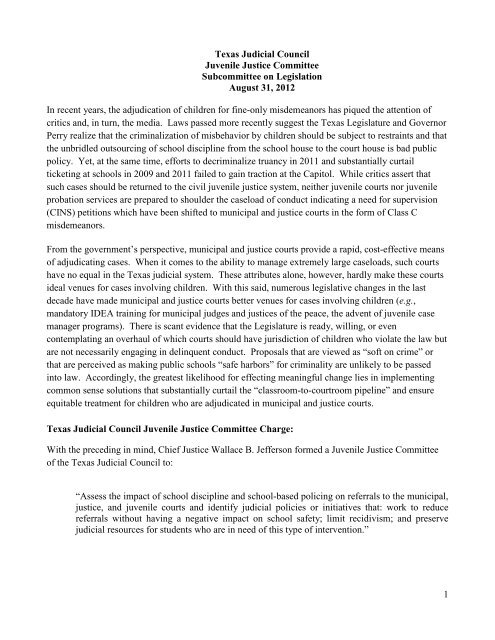
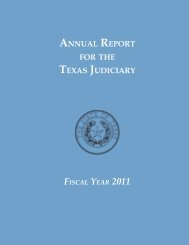
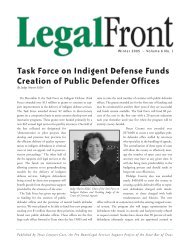
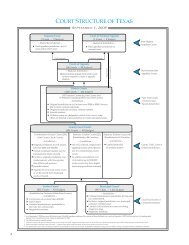

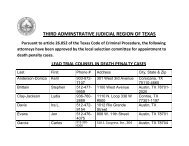
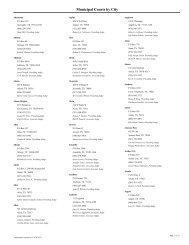
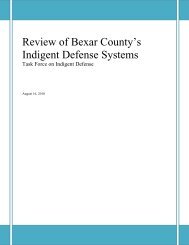
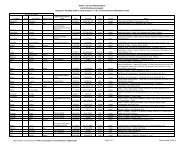


![Summary Report [pdf] - Texas Courts Online](https://img.yumpu.com/27405334/1/190x245/summary-report-pdf-texas-courts-online.jpg?quality=85)

